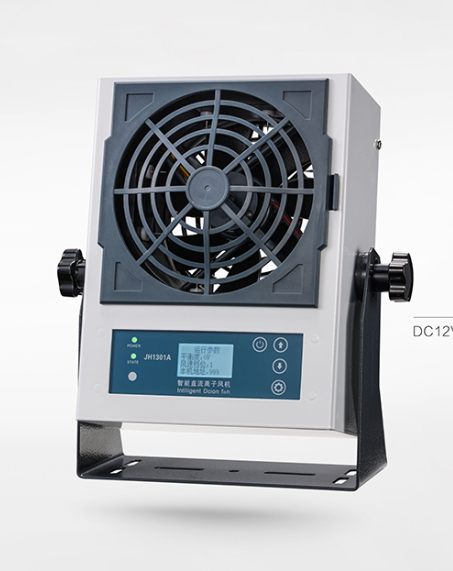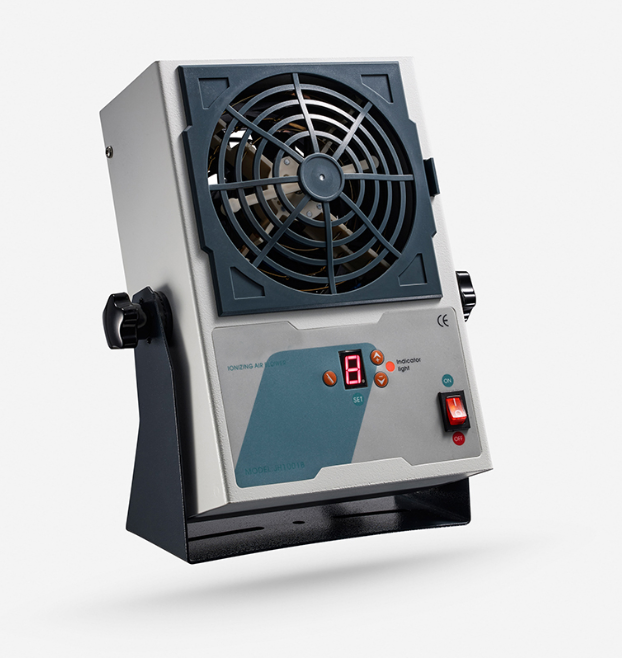An air ionizer fan is a device that combines the ionizing function with the air circulation capability of a fan. It releases negative ions (anions) into the air while circulating it to neutralize static electricity, reduce dust and airborne particles, and improve air quality. The combination of ionization and air circulation makes it a useful tool in environments where static control and clean air are essential.

Ionization:
The ionizer fan generates negative ions through a high-voltage electrical field. These ions are released into the air, where they seek out and attach to positively charged particles, such as dust, allergens, bacteria, and static charges.
Neutralizing Static Charges:
As the negative ions attach to the positively charged static electricity on surfaces or objects, they neutralize the charges, helping to prevent static buildup and the issues that come with it (such as ESD damage to electronics).
Air Circulation:
The fan circulates the air, ensuring that the ions are evenly distributed throughout the room. This not only helps in neutralizing static charges but also improves air quality by distributing ions that bind to dust particles, making them heavy enough to fall to the ground or get trapped in filters.
Reduces Static Electricity:
The primary function of an ionizer fan is to neutralize static electricity, which is crucial in environments where ESD (Electrostatic Discharge) can damage sensitive electronic components (like microchips or circuit boards).
Improves Air Quality:
Negative ions attract and neutralize airborne dust, pollen, allergens, and pollutants, creating a cleaner, healthier environment.
Prevents ESD (Electrostatic Discharge) Damage:
In industries like electronics manufacturing, server rooms, or cleanrooms, where even small static charges can cause significant damage to equipment, ionizer fans play a vital role in protecting electronics.
Reduces Allergens and Dust:
By binding to dust and allergens, the ions cause these particles to fall out of the air, improving breathability and overall air cleanliness in the room.
Improves Comfort:
In environments where static shocks are a frequent occurrence (like in dry or air-conditioned spaces), ionizer fans help in reducing the frequency of these shocks, making the workspace more comfortable.
Quiet Operation:
Many ionizer fans are designed to operate quietly, which is ideal for use in offices, laboratories, or homes where noise could be distracting.
Electronics Manufacturing: To protect delicate electronic components like microchips, displays, and PCBs from ESD damage during assembly or testing.
Cleanrooms and Laboratories: In environments that require static-free zones, such as pharmaceutical labs, medical device manufacturing, or biotech facilities.
Server Rooms and Data Centers: In data centers where electronic equipment is highly sensitive to static discharges.
Offices and Workstations: To improve air quality and reduce static electricity in workspaces with sensitive electronics (computers, printers, etc.).
Home Use: To reduce dust, allergens, and static shocks in dry or air-conditioned environments such as living rooms or home offices.
Ion Output Control:
Look for a fan with adjustable ion output to tailor the intensity based on the room size and your needs.
Fan Speed Settings:
A good air ionizer fan should have multiple speed settings to control the airflow, allowing you to adjust based on the space and the air circulation required.
Noise Level:
Choose a fan with a low noise level, especially if you plan to use it in quiet environments like offices or laboratories.
Portability:
Depending on the use case, consider a compact, portable unit that can be moved from one workstation to another or placed in different areas.
Filter System:
Some air ionizer fans come with built-in filters (e.g., HEPA filters) to trap and remove dust and allergens, improving the air quality further.
Maintenance:
Look for models that are easy to clean, with removable parts such as filters or ionizing plates that require minimal maintenance.

our air ionizer fan is a single head ion fan that can quickly remove static electricity in a large range, with an ion balance of ± 5V. The discharge electrode is replaceable and equipped with a high-definition LCD display screen. It has automatic cleaning function and is used in industries such as semiconductor, optoelectronics, medical, and food for static electricity removal.
| Voltage Input | DC24V | Adapter (AC 110~220V, 50~60Hz,DC 24V, 1.5A) |
| Power | 14.4W | Maximum wind speed |
| Current | 600mA | |
| Ion Generation Method | Steady DC | |
| Needle Tip Voltage | ±DC4000-DC6000V | |
| Discharge Structure | No coupled electrical contact | |
| Air Volume | 130 CFM | Maximum wind speed |
| Noise (dB) | 64dB | Maximum wind speed at a distance of 1000mm from the air outlet |
| Ion Balance | ±5V | At a distance of 300mm in front of the air outlet, at the time of factory |
| Static Elimination Time | ≤1.5s | Maximum wind speed at a distance of 300mm in front of the air outlet |
| Static Elimination Range | 900*300mm(L*W) | |
| Ozone Concentration | ≤0.05ppm | At a distance of 150mm from the air outlet |
| Operating Ambient Temperature | 0~+50℃(32~122F) | |
| Operating Ambient Humidity | 35~75% RH (no condensation, no freezing) | |
| Dimensions | 215*146*91.3 | |
| Enclosure Material | Aluminum | |
| Electrode Material | Tungsten | |
| Weight | 1.2kg (including bracket) | |
| Warranty | 1 year | |
| Certification Certificate | CE, UKCA |

Delivery is prompt!
By 10-year industry experts!
Diverse payment methods available!
Unbeatable cost performance!